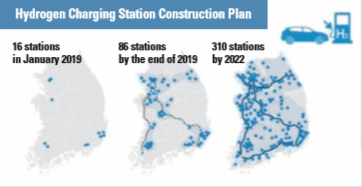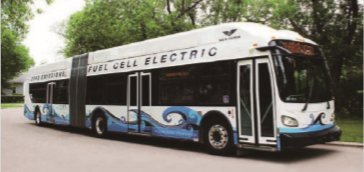The President of Korea, Moon Jae-in, visited the presentation for hydrogen economic vitalization which was held in Ulsan City Hall, where he emphasized Korea’s goal of becoming the number one in the hydrogen car and fuel cell market, at the beginning of the year. Accordingly, the National Assembly of Korea is planning to hold a series of forums about the hydrogen economy from March 6th to April 10th . The focus of the forum is on hydrogen cars, particularly as many citizens are optimistic about new eco-friendly cars, but there are also concerns associated with the cars. Therefore, the Sungkyun Times (SKT) will introduce the concept of hydrogen cars, their development and limitations, and their positive prospects.
An Outline of the Hydrogen Car
-The Development of Hydrogen Cars
As everyone might know, the internal combustion engine cars that most people use nowadays have low efficiency in terms of energy transfer and have problems with noise and air pollution. The energy delivered from the gasoline engine to the wheels is only 21% of the total fuel energy, which means that the other 79% of energy is lost during the energy transfer process. Therefore, if the same amount of fuel is charged, hydrogen can produce three times more energy than fossil fuel, and hydrogen cars can drive 100 kilometers with one kilogram of hydrogen. Not only are hydrogen cars efficient, but they are also eco-friendly. Hydrogen cars are often referred to as “running air purifiers” because they can purify the air without emitting exhaust gas. For efficient energy production, the cars need clean oxygen while they are running. Therefore, the cars use a triple filter system which includes an air filter, a humidifier, and a carbon fiber paper to clean up the air and release purified air. For example, the Nexo, one of the hydrogen cars from Hyundai, can purify 26.9 kilograms of air if they run for an hour. This amount is equivalent to the one-hour breathing capacity of 42 adults. For these reasons, it is a natural trend to see an increase in highly efficient and eco-friendly hydrogen cars on the market.
-How the Hydrogen Car Works
The hydrogen car is an electric car that uses hydrogen fuel cells. It uses catalysts like platinum to create electricity generated by hydrogen and oxygen. The structure of the hydrogen car is almost the same as the electric car. The primary parts of the hydrogen-powered car are a highpressure hydrogen tank which is a fuel tank and a fuel cell that reacts to hydrogen and oxygen. To put it simply, the high-pressure hydrogen tank and the fuel cell can be thought of as gasoline tank and engine of fossil-fueled cars. There are three steps that show how hydrogen cars are operated. First, the hydrogen stored in the hydrogen tank is sent to the electricity-generating unit, the fuel cell. Second, the fuel cell chemically reacts to hydrogen and oxygen to generate electricity and sends the reactants to the motor. Lastly, as the motor functions, electrical energy is converted into kinetic energy and moves the vehicle along.

Limits of Hydrogen Car Development
Five steps are required to drive a hydrogen car. 1. Hydrogen Production → 2. Storage and Transportation of Hydrogen → 3. Hydrogen Charge → 4. Electricity Generation → 5. Maintenance and Management. Regarding Step 1 and 2, there are problems with the hydrogen infrastructure, and at steps 3, 4 and 5 there are problems with hydrogen cars.
-Limits of Hydrogen Infrastructure
At the first step of hydrogen production, water electrolysis technology is used to make eco-friendly hydrogen energy. At this point, most of the electricity which is used for electrolysis of water is generated by fossil fuels such as coal and liquefied natural gas (LNG). If the demand for hydrogen increases due to the development of hydrogen cars, more fossil energy is expected to be consumed, which will make it hard to expect hydrogen cars to reduce carbon dioxide while producing eco-friendly energy. In the second step, a new pipeline and preservation container are necessary for the storage and transportation of hydrogen. Due to its permeability, hydrogen must be compressed or liquefied at high pressure and stored in a container of special material such as expensive carbon fiber. If an existing pipeline and a container are used without a necessary upgrade or modification, hydrogen may explode when in contact with the outside air. In the third step, there is a problem with the shortage of hydrogen charging stations in Korea. According to the Ministry of Trade, Industry, and Energy (MOTIE) of Korea, there are now only 16 hydrogen charging stations in Korea, and it shows that a convenient charging environment has not yet been built. Moreover, it costs about 3 billion won to build a hydrogen charging station, and the maintenance cost for an automatic monitoring system for safety is expensive as well. Therefore, it takes a large budget to build charging stations across the whole country.

-Limitations in Hydrogen Car Technology
There are two main limitations of Hydrogen cars: the capacity limits of the hydrogen storage tank and heat problems with the fuel cell. Hydrogen is the smallest and lightest material in the natural world, and it needs enormous storage space to contain enough amount. Furthermore, in a limited general vehicle structure, hydrogen must be compressed in the storage tank at high pressure. The high-pressure storage tank can hold up 700 bars in pressure, but if the pressure increases to over 700 bars, the hydrogen capacity does not increase as the pressure increases. This clearly demonstrates the technical limitations of the hydrogen storage capacity. The second limitation is the heat problem of the fuel cell. The fuel cell generates not only electricity but also heat. Since there is no vent for heat emission, forced circulation using coolant is necessary to cool down the heat. For this reason, a large-sized radiator is required to circulate as much coolant as possible to lower the temperature. A large-sized radiator, however, cannot be easily installed in a limited vehicle size. As a result, hydrogen cars have inherent structural difficulties because of the storage tank and fuel cell heat.
Positive Prospects for Hydrogen Car Development
-The Potential of Hydrogen Car
Despite the several limitations, the biggest reason to invest in hydrogen vehicles is the advancement of water electrolysis technology. The advanced technology is expected to be able to produce cheaper and more environment friendly hydrogen by using fewer fossil fuels. The MOTIE of Korea announced plans to increase the hydrogen supply to 5.26 million tons per year by 2040 to lower the hydrogen price from 8,000 won to 3,000 won. Since a hydrogen car can run 96.2 kilometers with one kilogram of hydrogen, it will be able to run for 93.2 kilometers for 3,000 won in the future. This decrease in unit cost of hydrogen can compensate for the cost of building hydrogen infrastructures such as hydrogen charging stations and transportation pipes. Likewise, the government plans to build 310 hydrogen charging stations nationwide by 2022. To achieve these potentials, the companies and the government must cooperate to build a consistent infrastructure for improvement of technology and accessibility.
-Suggestions to Maximize the Efficiency of Hydrogen Cars
As mentioned before, the large radiator that lowers the heat and the large hydrogen storage tanks are difficult to be mounted on a standard car. It, however, will be sufficiently competitive to operate relatively larger hydrogen vehicles with a larger hydrogen storage tank and a larger radiator, such as hydrogen buses, trucks and military vehicles, as well as other means of transportation such as trains and ships. In addition, the introduction of hydrogen public transportation like city buses and express buses will bring huge synergy. Since public transportation is operated on a fixed schedule, it is easy to predict the amount of hydrogen fuel needed for efficient running. Moreover, since the charging time for hydrogen cars is only 5 minutes, operation time can become more flexible. Due to the high energy efficiency of hydrogen cars, the charging station can be installed only at the final destination of transportation. If hydrogen fuel systems cannot be applied to commercial passenger cars due to limitations in technology or budget, public transportation with hydrogen systems could still produce substantial benefits like reducing public transportation costs and improvement in the atmospheric environment.

Currently, hydrogen car development seems like a loss due to the huge cost of investment for infrastructure. It is, however, too early to decide the utility and potentiality of hydrogen cars for the future. Therefore, it is desirable not only to focus on the development of the hydrogen cars but also to find a way to maximize the utilization of hydrogen cars by connecting them with social overhead capital. To achieve this, firms should manage investment flexibly as the market flows, and citizens should pay consistent attention to hydrogen cars
